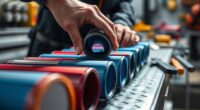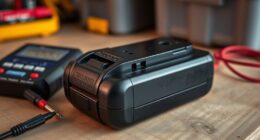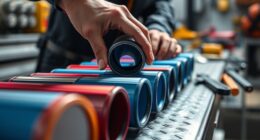If you’re after the best cooled CMOS astro cameras for deep sky imaging in 2025, I recommend the SVBONY SV605CC, with its 9MP sensor, excellent cooling for low noise, and stellar color accuracy. The Astromania SGCMOS Series also offers high resolution and reliable performance for detailed captures. Both deliver remarkable clarity and durability for extended imaging sessions. Stay with me, and you’ll discover more about why these models stand out and how to choose the perfect one for your needs.
Key Takeaways
- High-resolution sensors with 80% quantum efficiency ensure detailed deep sky imaging and enhanced stellar clarity.
- Advanced TEC cooling reduces sensor temperature by 30°C, minimizing noise and hot pixels during long exposures.
- Durable, CNC aluminum housings provide environmental resistance for reliable, long-term astrophotography use.
- Software compatibility with Windows, Linux, and Mac supports seamless control, live preview, and high-quality image stacking.
- Optimized sensor sizes and pixel resolutions balance field of view and image detail for precise deep sky captures.
SVBONY SV605CC Cooled Camera, 9MP CMOS Color Telescope Camera

If you’re serious about deep sky astrophotography, the SVBONY SV605CC cooled camera is an excellent choice because it combines high-resolution imaging with advanced cooling technology. Its 9MP CMOS sensor, featuring the IMX533 chip, captures stunning detail with 3008×3008 resolution and an 80% quantum efficiency. The camera’s double-layer TEC cooling system lowers temperatures by 30°C below ambient, reducing thermal noise during long exposures. Glow suppression technology ensures clearer images by minimizing residual glow, especially in low-light conditions. Its versatile compatibility with Windows, Mac, Linux, and Raspberry Pi makes it suitable for both indoor and outdoor setups, perfect for enthusiasts and professionals alike.
Best For: amateur and professional astronomers seeking high-resolution, low-noise deep sky astrophotography with versatile compatibility and advanced cooling technology.
Pros:
- High-resolution 9MP CMOS sensor with 3008×3008 pixels for detailed imaging
- Effective TEC cooling system reduces sensor temperature by 30°C, minimizing thermal noise during long exposures
- Glow suppression technology enhances image clarity in low-light conditions
Cons:
- Requires compatible software and hardware setup, which may be complex for beginners
- Cooling system adds to the camera’s size and power consumption
- May be more expensive compared to basic astrophotography cameras without cooling features
Astromania SGCMOS Series Telescope CMOS Camera
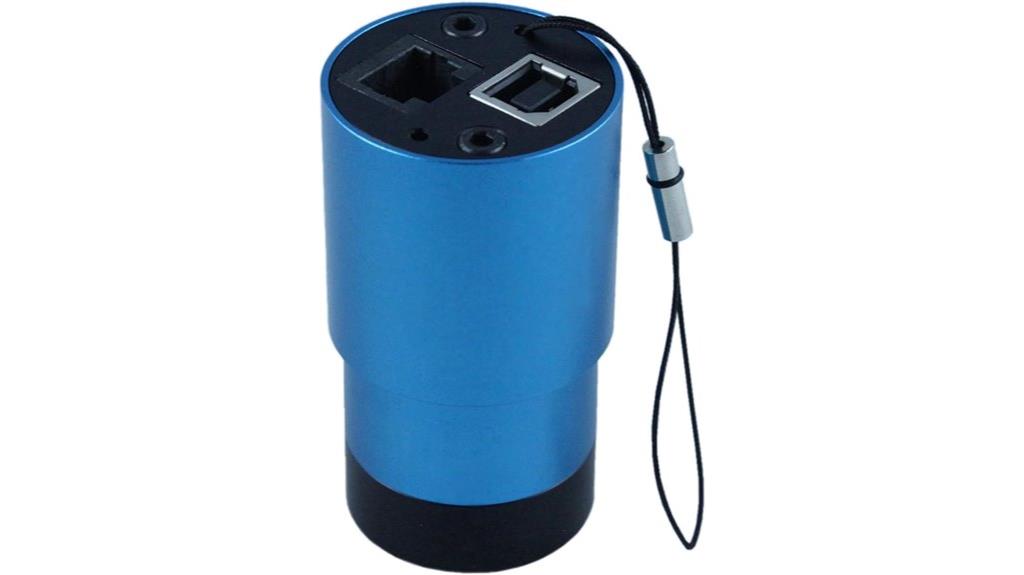
The Astromania SGCMOS Series Telescope CMOS Camera is an excellent choice for amateur astrophotographers seeking a versatile and affordable tool for auto-guiding and deep-sky imaging. It features a high-sensitivity sensor, fast frame rates, and long exposure support, making it suitable for capturing faint objects. Its CNC aluminum housing includes a 1.25-inch nosepiece for precise focusing and filter installation, along with a C-mount for industrial lenses. Equipped with a built-in ST4 auto guider port and compatibility with Windows, Linux, and third-party software, it offers flexible imaging options. Despite some driver and sensitivity limitations, it remains a popular entry-level option for guiding and multicolor astrophotography.
Best For: Amateur astrophotographers and stargazing enthusiasts seeking an affordable, versatile auto-guiding and deep-sky imaging camera with multi-platform compatibility.
Pros:
- High-sensitivity sensor with fast frame rates suitable for capturing faint objects and long exposures
- Includes a built-in ST4 auto guider port for easy guiding setup
- Compatible with Windows, Linux, and third-party astrophotography software, offering flexible imaging options
Cons:
- Driver issues such as unsigned drivers and limited support for Windows 11 may hinder installation and use
- Lower sensitivity compared to higher-end cameras, requiring longer exposures for faint objects
- Limited compatibility and potential focusing challenges with certain lenses or setups
Factors to Consider When Choosing Cooled CMOS Astro Cameras for Deep Sky Imaging
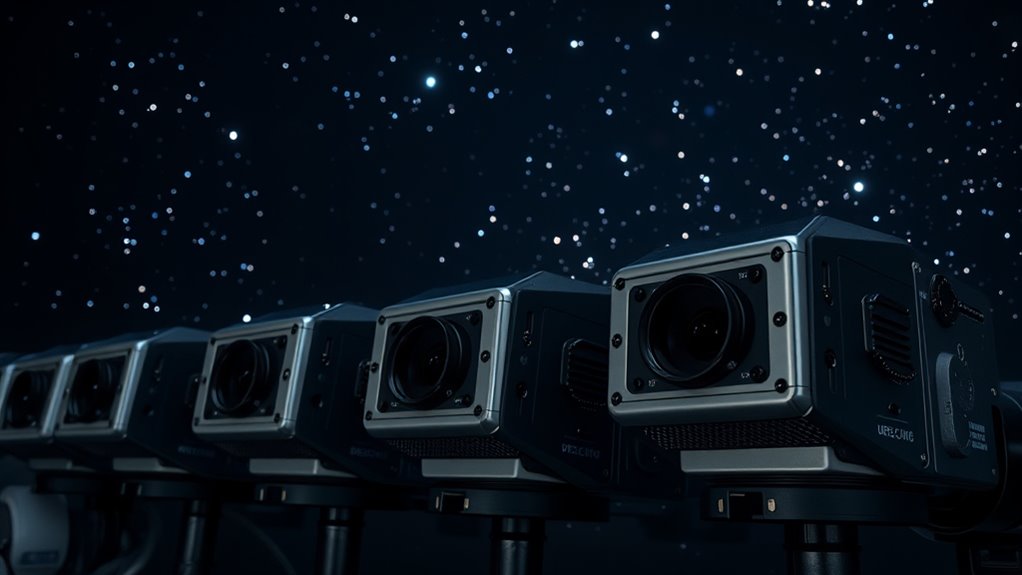
When selecting a cooled CMOS astro camera, I focus on several key factors to guarantee quality imaging. Things like sensor sensitivity, cooling performance, and software compatibility can make a big difference in results. Let’s explore these points to help you choose the best camera for your deep sky imaging needs.
Sensor Sensitivity and QE
Have you ever wondered how some astro cameras manage to capture faint detail in deep sky objects? The key lies in sensor sensitivity and quantum efficiency (QE). QE measures how effectively a sensor converts incoming photons into electrical signals, directly affecting low-light performance. Cameras with high QE—above 80%—maximize photon collection, revealing more detail in faint objects. The spectral response of the sensor, aligning with its QE curve, determines sensitivity across different wavelengths, which is crucial for multi-filter imaging. A sensor with high sensitivity and QE delivers a better signal-to-noise ratio, meaning clearer images and shorter exposure times. When choosing a cooled CMOS camera, prioritizing high QE ensures you get the most detail and brightness from your deep sky shots, even in challenging conditions.
Cooling Efficiency and Noise Reduction
Effective cooling systems like TEC or Peltier modules are vital for minimizing sensor temperature during astrophotography. They can lower sensor temps by 20-30°C below ambient, drastically reducing thermal noise. Cooler sensors produce fewer hot pixels and less dark current, which are major sources of unwanted noise in long exposures. High cooling efficiency boosts the signal-to-noise ratio, allowing me to capture faint deep-sky objects with more detail and clarity. Proper thermal management, including heat transfer to heat sinks or the camera body, prevents heat buildup that can degrade image quality. Consistent temperature control during imaging sessions ensures stable noise levels, maintaining high image quality across extended exposures. Prioritizing cooling efficiency is essential for achieving stellar clarity in deep-sky astrophotography.
Compatibility and Software Support
Choosing a cooled CMOS astro camera that’s compatible with your operating system and software ecosystem is essential for smooth imaging sessions. I always check if the camera supports major platforms like Windows, macOS, or Linux, ensuring seamless operation. Compatibility with essential software protocols such as ASCOM, INDI, or dedicated astrophotography programs is crucial for easy control and image processing. I verify that the camera has signed, regularly updated drivers compatible with current OS versions like Windows 10 and 11, which helps maintain stability. Additionally, I look for software tools for live preview, long-exposure stacking, and post-processing, as they’re indispensable for deep sky imaging workflows. Lastly, standard interfaces like USB 3.0 or C-mount simplify integration with existing hardware, making setup straightforward and reliable.
Image Resolution and Field of View
When selecting a cooled CMOS astro camera for deep sky imaging, understanding the relationship between image resolution and field of view is vital. Higher resolution cameras, like those with 9MP sensors (3008×3008 pixels), capture finer details and help resolve faint objects more clearly. The field of view (FOV) depends on sensor size and focal length; larger sensors, such as the 1-inch IMX533, offer wider views ideal for panoramic shots. However, increasing resolution results in larger data files and longer processing times, so balancing pixel count with system capacity is key. Pixel size, like 3.76μm, affects both resolution and sensitivity—smaller pixels yield sharper images but demand better tracking accuracy. Choosing the right combination ensures you get detailed images without overwhelming your equipment.
Durability and Build Quality
Durability and build quality are essential factors because they directly impact a cooled CMOS astro camera’s ability to perform reliably in challenging outdoor conditions. A sturdy metal housing, often CNC aluminum, helps the camera withstand temperature swings and physical impacts. High-quality materials and precise manufacturing protect internal components from dust, moisture, and shocks, guaranteeing longevity. Reliable cooling systems like TEC refrigeration depend on effective thermal management to prevent condensation and sensor damage. Secure, vibration-resistant connections for power and data minimize failures during long exposures. Overall, a well-built camera resists environmental stressors, maintains consistent performance, and lasts longer, making it a dependable choice for serious astrophotographers. Investing in durability and quality ultimately ensures your equipment can handle the demands of deep sky imaging over time.
Frequently Asked Questions
How Do Cooled CMOS Cameras Compare to CCD Cameras for Deep Sky Imaging?
Cooled CMOS cameras are generally more affordable and lightweight than CCDs, making them easier to use for deep sky imaging. They offer high sensitivity, fast frame rates, and lower power consumption, which helps capture detailed images efficiently. While CCDs still excel in noise reduction and dynamic range, CMOS cameras have come a long way and now provide excellent stellar clarity, making them a popular choice for many astrophotographers.
What Is the Ideal Cooling Temperature for Optimal CMOS Astro Camera Performance?
Did you know that cooling a CMOS astro camera to around -10°C can reduce thermal noise by up to 90%? I’ve found that maintaining an ideal cooling temperature around this range really enhances image quality without risking condensation. Going colder doesn’t always mean better, as it can cause other issues like condensation or increased power use. So, I aim for that sweet spot for stellar clarity without complications.
Are These Cameras Compatible With All Major Telescope Brands and Mounts?
These cameras are generally compatible with most major telescope brands and mounts, but I always recommend double-checking the specific model’s compatibility. I look for cameras with versatile connection options like USB or Ethernet and adaptable mounting plates. If you’re using a popular mount like Celestron or Sky-Watcher, compatibility is usually seamless, but it’s wise to verify the specifications to avoid surprises during setup.
How Does Sensor Size Impact Image Quality in Cooled CMOS Astro Cameras?
Sensor size impacts image quality by affecting field of view, detail, and low-light performance. Larger sensors capture more light, resulting in brighter, sharper images with greater detail, especially in deep sky imaging. Smaller sensors, while more compact and easier to manage, often produce narrower fields of view and less detail. I find that choosing the right sensor size depends on your target objects and desired image quality, balancing size with performance.
What Maintenance Routines Are Recommended for Long-Term Camera Performance?
To guarantee long-term camera performance, I recommend regularly cleaning the sensor and camera body with appropriate tools to prevent dust buildup. I also perform software updates, check cooling system efficiency, and inspect cables and connections for wear. Storing the camera in a dry, dust-free environment helps prevent corrosion. Finally, I run calibration frames periodically to maintain image quality, making sure my equipment stays in top shape for stellar imaging.
Conclusion
Choosing the right cooled CMOS astro camera can truly transform your deep sky imaging experience. I remember a fellow stargazer who captured breathtaking nebulae after switching to a high-sensitivity model—her joy was unforgettable. Whether you opt for the SVBONY SV605CC or the Astromania SGCMOS, investing in quality means capturing those elusive stars with clarity and detail. Trust me, the night sky’s secrets become yours to reveal—and that’s an incredible feeling.

